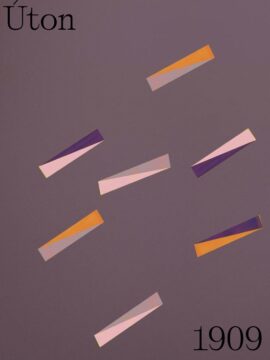
The new volume published by the Kassák Museum focuses on one of the defining, early events of Lajos Kassák’s work and analyses it with new methods and sources. The volume On the Road 1909: Kassák, Szittya, Long Poems, Short Revolutions, published in Hungarian and English in an online, open access format is the result of several years of work.
In Spring 1909, influenced by modernist Hungarian literature and the poet Endre Ady in particular, Lajos Kassák set off for Paris to immerse himself in the European capital commonly regarded as the catalyst of modern culture. He made the entire journey, which lasted more than half a year, on foot. The experiences, acquaintances, and connections he gathered en route would later greatly influence the evolution of his career in the first half of the 1910s, as well as his work organising the nascent Hungarian avant-garde group he led.
In the 1920s, Kassák wrote about his 1909 experiences in two stylistically different literary texts, both of which influenced his later works. The first was A ló meghal a madarak kirepülnek (The Horse Dies the Birds Fly Away), a long poem citing Dadaist influences, written in 1920 and first published in 1922. The second text was his 1927 autobiographical novel Egy ember élete (The Life of a Man), the third volume of which, entitled Csavargások (Vagabondage) narrated the story of his journey to Paris.
At the centre of this present volume are these two works, perhaps the most-cited and best known of Kassák’s texts among Hungarian and also international readers. Both works are reproduced here in full, in both Hungarian and English. The poem A ló meghal a madarak kirepülnek was translated into English in 1987 by the Scottish writer and translator Edwin Morgan, while the Csavargások chapter of Egy ember élete is published here for the first time in English, translated by Adél Várszegi. We are publishing these two standard works together with studies shedding new light on the contexts of their genesis, as well as supplementary sources. In the interests of completeness, we are also publishing Kassák’s earlier poems and his correspondence from the period, which is held at the Kassák Museum, as well as recollections, photographs, and explanatory notes.
As with Kassák’s literary works and oeuvre, this symbolic centre of this volume is his 1909 Western European vagabondage. In both works discussed here, Kassák interpreted his journey unambiguously as the story of his own development as a poet, as LAJOS KASSÁK. Yet the real transformation within him – and unlike in the case of the Francophone modernist writers and artists – was not triggered by Paris, but by something completely different: the act of vagabondage, the journey, and the bohemians and outsiders he met en route. For Kassák, the experience of becoming a poet arose from a very different, atypical situation. It is this ‘journey’ experience that the title of our volume evokes, paraphrasing the title of Jack Kerouac’s Beat novel, which has influenced a way of life for generations.
Edited by Edit Sasvári and Merse Pál Szeredi
Essays by Magdolna Gucsa, Márió Z. Nemes, Tamás Seregi and Merse Pál Szeredi
English translations by Gwen Jones, Edwin Morgan and Adél Várszegi
Cover design by Klára Rudas
Design and prepress by Virág Bogyó
The Hungarian and English editions of the volume are available through the OPAC of the Petőfi Literary Museum:
The publication of this volume was made possible through the support of the Fondation Jan Michalski (Montricher, Switzerland).